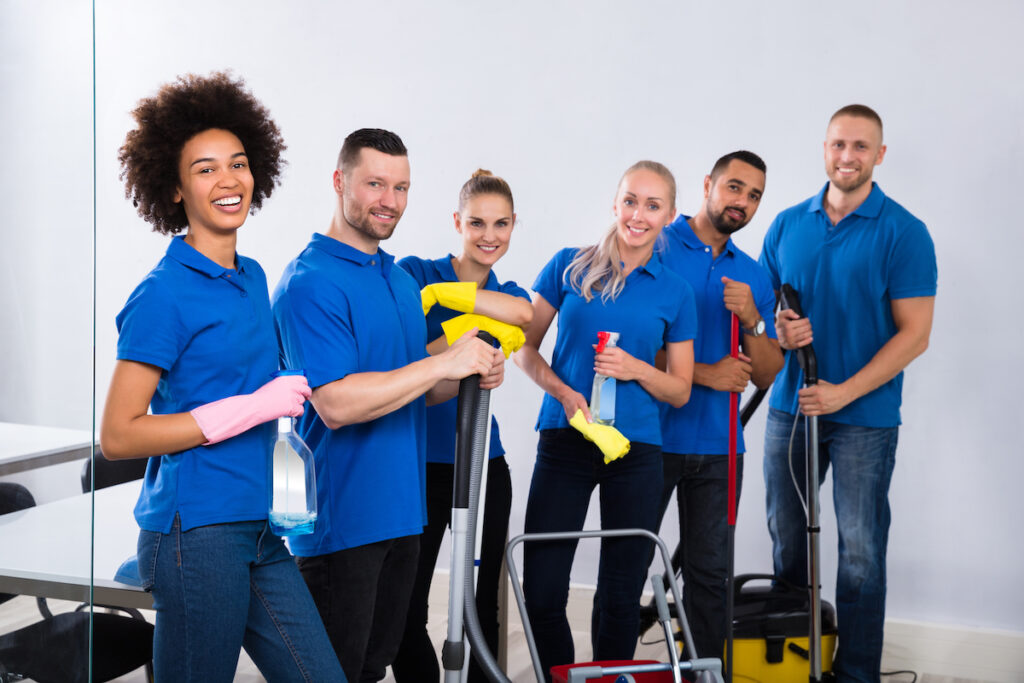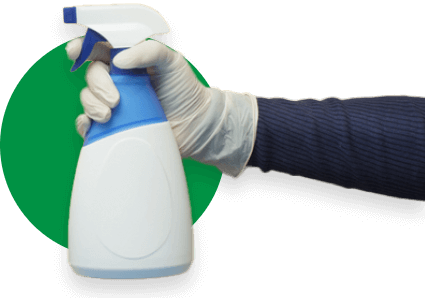With any type of public or private space, it is important to maintain a level of cleanliness and sanitation. Typically, it is best to hire the services of a commercial cleaning company as they will have the knowledge and expertise needed to properly complete tasks.
Along with hiring a cleaning crew, implementing a cleaning staff checklist can be quite helpful. This way, you can ensure that each task is done correctly and efficiently. In this article, we will explain everything you need to know about the perfect cleaning staff checklist.
Cleaning Checklist: What It Is & Why It’s Important
To begin, a cleaning checklist is a tool commercial companies use to ensure that tasks are completed efficiently and effectively. In addition, cleaning checklists can feature various levels of detail. Certain lists may only include services that must be completed.
Alternatively, checklists can be more thorough and include procedures and schedules to follow. Either style can work; however, you must adjust your list based on your staff members and the level of cleaning needed. Understandably, places that require greater amounts of labor and extensiveness may need a more detailed cleaning checklist.
It is highly important to use a cleaning checklist, even if your crew is experienced. A list is a simple tool that helps keep everyone focused and organized. Furthermore, COVID-19 has increased the need for sanitary and well-maintained spaces. With that being said, a checklist helps guarantee that all areas are properly cleaned, sanitized, and disinfected.
Creating a Cleaning Staff Checklist
Everyone should create a staff cleaning checklist as it is effective and does not require significant amounts of energy. In actuality, you can create a great checklist by understanding your crew and the level of cleaning needed.
Before you begin, you should include all members of your staff in the list-making process. If you genuinely listen to your crew, you can make them feel appreciated. In addition to improving overall morale, it may result in them working more efficiently and effectively. This is because tasks can be delegated according to everyone’s experience, skill, and strength.
Afterward, you must assess and analyze each task that needs to be completed. You should also take into account the level of frequency. By doing so, you can gain a better estimation of cleaning time.
Moving on, you should lay out the tasks in a logical manner. For example, it may be best to complete basic cleaning tasks first. This includes the cleaning of surfaces. Then, you can vacuum carpets or focus on hard-to-reach areas. Alternatively, you can focus on certain areas first, such as lobbies or restrooms.
Finally, you should regularly review your cleaning staff checklist during the creation process. This way, you can ensure that all tasks are included and the appropriate level of detail is written. Furthermore, you can make revisions when needed.
4 Types of Cleaning Checklists
There are different types of cleaning checklists that you can implement. It is important to fully establish what type of list you need and the level of detail required. That way, you can write one that best fits the situation.
Most often, cleaning checklists should be tailored to the environment and level of extensiveness needed. While it may take extra effort to fine-tune your checklist, it is worth it.

By Area
First off, cleaning checklists can be developed based on area. This means focusing on specific places first, as they may require the most time and effort. For example, in most spaces, restrooms are of the highest cleaning priority. This is because they are high-traffic and high-contact areas. Also, since they can hold a significant amount of germs and bacteria, individuals are more vulnerable to exposure and illnesses. When cleaning restrooms, staff members will replace necessary items such as toilet paper and soap. Afterward, they will pre-treat and clean all toilets and urinals. They also must clean and disinfect all sinks, faucets, and doorknobs.
In other instances, cleaning crews may focus on the kitchen as it also harbors large amounts of viruses and bacteria. These are food storage areas and must be thoroughly addressed. Professionals will properly disinfect all sinks and countertops. Then, they will clean and remove grease from stovetops and ovens. To continue, they will mop the floor. Finally, they will clean places that are difficult to reach, like behind the refrigerator.
By Frequency
Moving on, commercial cleaning companies may formulate their list based on the level of frequency needed. Typically, it will be broken down between daily, weekly, and monthly cleaning.
To start, daily cleaning includes simple tasks that can be completed regularly to ensure an adequately sanitary space. For example, in an office building, you should dust flat surfaces, clean blinds, and mop floors. In addition, routine tasks include spraying fabric-safe disinfectant on chairs and curtains. Therefore, a specialized office cleaning checklist would be helpful.
Furthermore, weekly cleaning is typically done in medium to large size spaces. Since there is a greater square foot area, daily cleaning may not be efficient. Therefore, it is best to have weekly services that are thorough and extensive. Typically, this type of cleaning is performed in apartment buildings or large businesses. Certain tasks include the cleaning of surfaces in the lobby or reception area. Also, furniture may be moved to clean smaller or hard-to-reach places.
Finally, monthly cleaning tasks are the most intensive and require the longest amount of time and effort. This is also known as deep cleaning. They can be completed in any public or private space. For example, restaurants may hire commercial cleaning companies for routine grease trap cleaning. In addition, any carpet may be thoroughly cleaned to remove all dirt, debris, and stains.
By Industry
It is important to specialize your cleaning staff checklist depending on the industry or type of space. Understandably, restaurants require different types of cleaning services than hospitals or schools.
In general, there is a standard commercial cleaning checklist that can apply to most places. This would involve wiping and disinfecting all flat surfaces and cleaning floors. This type of list is mostly used for malls or recreation centers.
Furthermore, there are checklists designated for hotel cleaning. Since they are meant to be luxurious and high-quality spaces, services can be more intensive. Hotel management may want to go above regular cleaning standards as it can increase customer and guest satisfaction. Lists like these should be well-detailed.
By Scope
Lastly, it can be helpful to organize your cleaning chart by scope. By doing so, you can ensure that each task, regardless of difficulty, is properly completed.
You can include a sign-off sheet in your office cleaning checklist, making sure that each person is completing the task they are assigned. This is a simple way to keep everyone accountable and can reduce inefficiency.
In addition, experienced staff members can oversee tasks such as the cleaning of floors. This will guarantee that they are being done properly. At the end of the day, they can check the cleaning chart to see if everything is completed.
Tips For Implementing Cleaning Staff Checklists
There are several different ways to effectively implement a cleaning staff checklist. Firstly, you can properly communicate with and train staff members. If everyone has the necessary skills and understands the level of competency required, tasks can be done properly and on time. Moving on, you can provide incentives to those who follow cleaning checklists. This can motivate others to do the same as well.
The first step of proper implementation is structure and designation. The cleaning checklist should be logical and easy to follow. Afterward, you should designate tasks based on skill and experience level. This is a great way to ensure that everyone is playing to their strengths.
Also, it may be helpful to perform inspections and quality checks. By doing so, you are showing that the checklist is important and should be followed. Also, it can help protect you from liability claims.
FAQs About Cleaning Checklists
How do you evaluate a cleaning staff?
There are many ways to evaluate a cleaning staff. Depending on your business, being a team player may be of high importance. Often, you should evaluate a cleaning staff based on their quality of work. For example, how do they do with cleaning blinds, cleaning surfaces, and disinfecting? If they are completing cleaning duties properly and efficiently, they should be regarded highly.
How do I make a cleaning schedule checklist?
You can make a cleaning checklist by fully understanding the tasks that must be completed, the location, and the strengths of your staff members. In addition, you can create a checklist based on cleaning frequency or industry.
What should a cleaning checklist include?
A checklist should include all the required tasks and who certain cleaning duties are assigned to. Furthermore, it must include various cleaning areas. Also, you may want to write down all necessary materials.
How do you monitor cleaning staff?
You can monitor a cleaning staff by implementing a sign-off sheet or assigning a senior member to inspection duty. In addition, proper communication between the cleaning crew can be helpful.
Interested in Learning More? Contact Us!
If you want to learn more about commercial cleaning services, look no further than Dallas Janitorial. You can give us a call at 214-778-3689. Our team of experienced staff members would love to help you.


